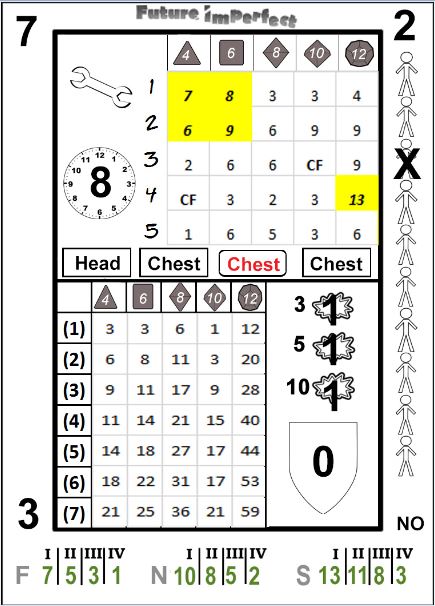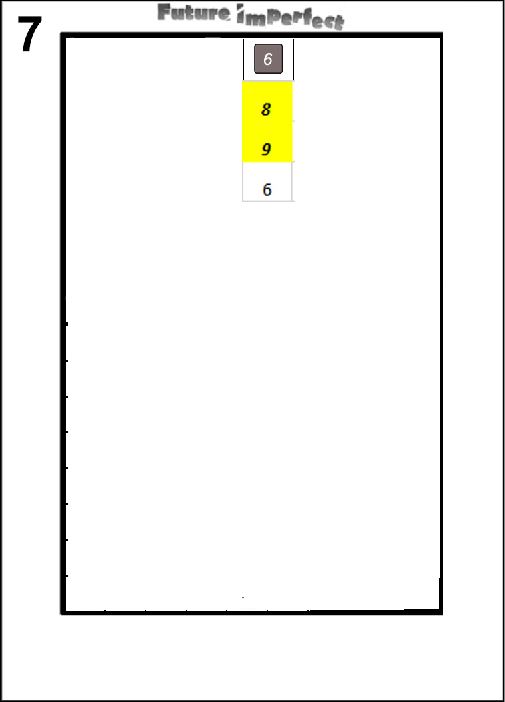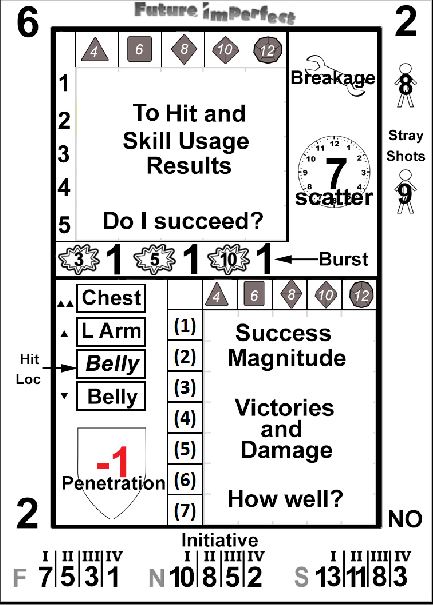Difference between revisions of "Action Card Concepts"
(Created page with "The action cards provided with Future Imperfect are powered by a few fundamental concepts that combine to make them deliver all the results necessary to keep the action at you...") |
|||
| (6 intermediate revisions by the same user not shown) | |||
| Line 1: | Line 1: | ||
The action cards provided with Future Imperfect are powered by a few fundamental concepts that combine to make them deliver all the results necessary to keep the action at your table fast and detailed. What follows is a discussion of the concepts. | The action cards provided with Future Imperfect are powered by a few fundamental concepts that combine to make them deliver all the results necessary to keep the action at your table fast and detailed. What follows is a discussion of the concepts. | ||
| − | =Concept 1: Use What You Need | + | =Concept 1: Use What You Need, Ignore Everything Else= |
| − | The cards are packed with data. If you needed to reference all, or even more than a few, of the items on the card, they would be untenable at the table. The first concept is learning to view only what is necessary. For example, if Sid Scorpio has 3d6 in Bravery, and the | + | The cards are packed with data. If you needed to reference all, or even more than a few, of the items on the card, they would be untenable at the table. The first concept is learning to view only what is necessary. For example, if Sid Scorpio has 3d6 in Bravery, and the Judge asks for a Bravery check, card 7: |
[[image:card7.JPG]] | [[image:card7.JPG]] | ||
| Line 8: | Line 8: | ||
Becomes: | Becomes: | ||
| − | [[image:73d6. | + | [[image:73d6.JPG]] |
| − | Simplify the card, and simplify your resolution. If the action evolves in a way that more entries are required for resolution, add them as necessary. But remember the second concept. | + | Simplify the card, and simplify your resolution. Think of the card design like this: |
| + | |||
| + | [[image:simplified.JPG]] | ||
| + | |||
| + | If the action evolves in a way that more entries are required for resolution, add them as necessary. But remember the second concept. | ||
=Concept 2: One Card, One Resolution= | =Concept 2: One Card, One Resolution= | ||
| Line 19: | Line 23: | ||
Also, when a resolution is complete, discard the card. Only use the results on a drawn card for a single resolution. If the situation being resolved becomes more complex and requires more information to resolve, then more entries on the card may be used. If, however, a second situation develops based on the result of the initial action, ''draw a new card to resolve it''. | Also, when a resolution is complete, discard the card. Only use the results on a drawn card for a single resolution. If the situation being resolved becomes more complex and requires more information to resolve, then more entries on the card may be used. If, however, a second situation develops based on the result of the initial action, ''draw a new card to resolve it''. | ||
| − | =Concept 3: | + | =Concept 3: Leave the Book On the Shelf= |
| − | + | Future Imperfect is designed to be played with a character sheet and a set of action cards. The cards are designed so that the rulebook almost never needs to be referenced. Let the game flow from the table, and dont worry about anything else. | |
Latest revision as of 01:46, 29 April 2019
The action cards provided with Future Imperfect are powered by a few fundamental concepts that combine to make them deliver all the results necessary to keep the action at your table fast and detailed. What follows is a discussion of the concepts.
Concept 1: Use What You Need, Ignore Everything Else
The cards are packed with data. If you needed to reference all, or even more than a few, of the items on the card, they would be untenable at the table. The first concept is learning to view only what is necessary. For example, if Sid Scorpio has 3d6 in Bravery, and the Judge asks for a Bravery check, card 7:
Becomes:
Simplify the card, and simplify your resolution. Think of the card design like this:
If the action evolves in a way that more entries are required for resolution, add them as necessary. But remember the second concept.
Concept 2: One Card, One Resolution
In Future Imperfect, the cards are designed to have all of the data required to resolve any situation. There is never a time a second (or subsequent) card is required to resolve an action.
Two kinds of optional rules can cause additional draws, but in these cases only a single portion of the following card is used, and these future cards are considered to extend the initial card, not replace it. These situations are exceptional results and the very reliable equipment attribute.
Also, when a resolution is complete, discard the card. Only use the results on a drawn card for a single resolution. If the situation being resolved becomes more complex and requires more information to resolve, then more entries on the card may be used. If, however, a second situation develops based on the result of the initial action, draw a new card to resolve it.
Concept 3: Leave the Book On the Shelf
Future Imperfect is designed to be played with a character sheet and a set of action cards. The cards are designed so that the rulebook almost never needs to be referenced. Let the game flow from the table, and dont worry about anything else.


